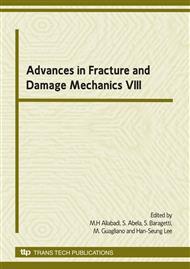p.317
p.321
p.325
p.329
p.333
p.337
p.341
p.345
p.349
Fatigue Behaviour of a Stainless Steel Based on Energy Measurements
Abstract:
In this paper the low cycle fatigue behaviour of an AISI 304L stainless steel is analysed on the basis of energy concepts. In particular during the fatigue tests different forms of energy in a unit volume of material per cycle involved in the fatigue process were measured: the mechanical energy expended was evaluated from the area of the hysteresis loops, while the energy released as heat by the specimen to the surroundings was estimated from surface temperature measurements by means of an infrared camera. By subtracting the mechanical input energy and that released as heat, the energy stored in a unit volume of material at fracture was calculated for each tested specimen. The mean value obtained from different specimens is in agreement with the energy absorbed by the material in a static test.
Info:
Periodical:
Pages:
333-336
Citation:
Online since:
October 2009
Authors:
Price:
Сopyright:
© 2010 Trans Tech Publications Ltd. All Rights Reserved
Share:
Citation:


